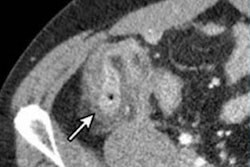Virtual/augmented reality (VR/AR) headsets show promise for helping clinicians interpret CT exams -- even for conditions such as diverticulitis, which can be tricky to diagnose, researchers have reported.
A team led by Paul Murphy, MD, PhD, of the University of California, San Diego observed that a VR/AR headset performed comparably to a desktop computer for the diagnosis of diverticulitis. The results were published November 4 in the Journal of Imaging Informatics in Medicine.
"[We found that] diagnostic performance for detecting diverticulitis on CT was similar between the next-generation VR/AR headset and a desktop [computer]," the group wrote.
Previous research has suggested that currently available virtual/augmented reality (VR/AR) headsets may rival desktop computer systems when it comes to evaluating radiologic images; some VR/AR headsets contain up to 23 million pixels at a 7.5 μm pitch, while 4K desktop monitors have 8 million pixels at around a 200 μm pitch, the investigators noted.
The use of these headsets instead of desktop displays has been explored for both image-guided procedures and diagnostic interpretation. But there's a complication.
"Organic light emitting diode … displays used in some headsets have high maximum luminance, but calibration to the DICOM grayscale display function, which deviates from linearity at low luminance, may not be simple to verify due to the user interface of the headset," Murphy and colleagues noted.
The team compared the diagnostic performance for detecting diverticulitis on CT between radiologists using a headset (Apple Vision Pro) and a desktop viewer app (Visage Ease VP) via a study that included 110 patients who underwent abdomen/pelvis CT scans (and for which the exam report noted the presence or absence of diverticulitis). Six radiologist readers rated the exams on a six-level scale for the condition (1 = no diverticulitis, 6 = diverticulitis). The readers also completed a five-level survey on ease of use of the headset and the desktop computer viewer app (1 = difficult, 5 = easy); about their experience with the headset (1 = bad, 5 = good); and about their preference between devices (1 = desktop, 5 = headset). The investigators also tracked interpretation time per case.
Murphy's group found the following:
| Comparison of performance of a VR/AR headset to desktop computer for diagnosis of diverticulitis | ||
|---|---|---|
| Measure | Desktop | VR/AR headset |
| Area under the receiver operating curve (AUC) | 0.94 | 0.93 |
| Interpretation time per case (seconds) | 31 | 57 |
It also reported that average survey scores regarding the VR/AR headset ranged among the radiologist readers from 3.3 to 5 for ease of use; from 3 to 4.7 for positive experience; and from 2.2 to 3.3 for preference.
Why the interpretation time difference -- and in favor of the desktop computer? This finding could be related to the fact that readers were more familiar with the desktop system, while the headset had been released for only three months, and that downloading cases to the headset over Wi-Fi could have taken longer than downloading images to the desktop computer via the Ethernet, the group wrote.
The investigators conceded that the study was limited by its relatively small size and called for "future studies with a larger number of readers … to explain variations in performance and preference among individual radiologists."
In any case, the study findings could be important for the development of new ways to interpret CT images, according to the group.
"[The] headset offers new opportunities for 3D visualization through its immersive display and new possibilities for ergonomics through the eye and hand tracking of its user interface," Murphy and colleagues concluded. "For these reasons, next-generation VR/AR headsets are promising for many applications throughout radiology."
The complete study can be found here.




















